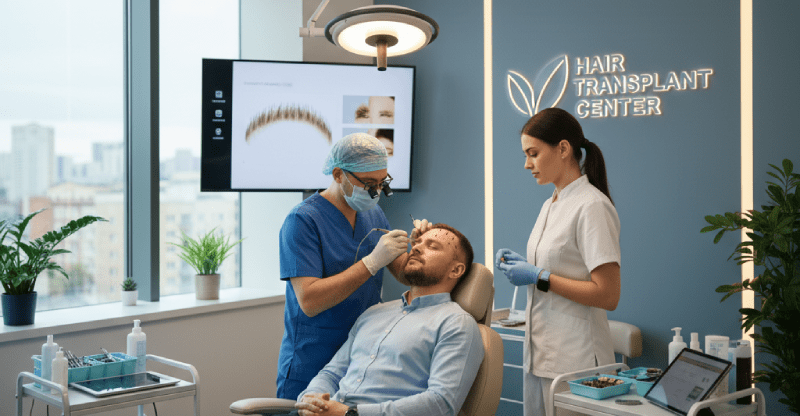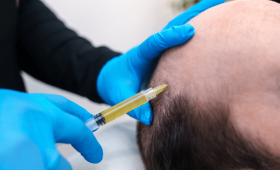What Is a 5000 Graft Hair Transplant?
A 5000-graft hair transplant is a comprehensive procedure applied to patients who have experienced extensive hair loss or desire high density. This quantity is often sufficient to effectively cover significant baldness in the frontal, mid-scalp, and crown areas. On average, 5000 grafts can equate to 10,000 to 15,000 hair strands, allowing for a very full and natural-looking result. This high-volume procedure demands the expertise of a skilled hair transplant surgeon and a meticulous, detailed planning approach.
Who Is a Suitable Candidate for a 5000-Graft Hair Transplant?
This procedure is ideal for individuals who have reached a high level of baldness, typically a Norwood scale of 5 or 6. The most crucial requirement for a suitable candidate is that their donor area—usually the back and sides of the head—must have sufficient density and quality to provide 5000 healthy grafts without compromising the donor area’s appearance. Additionally, the individual must be in good general health with no underlying medical conditions that would contraindicate the procedure.
How Long Does a 5000-Graft Hair Transplant Take?
A hair transplant procedure involving a high number of grafts like 5000 is typically performed in a single, long session or over two consecutive days. The duration of this operation can range from 6 to 10 hours on average. The length of the session depends on the technique used (FUE or DHI), the experience of the surgeon and their team, and the patient’s hair and skin characteristics. A meticulous approach is crucial, so taking sufficient time for the procedure is essential.
Why Do 5000-Graft Hair Transplant Prices Vary?
The prices for a 5000-graft hair transplant vary widely due to several factors. These include the specific hair transplant technique used (e.g., Sapphire FUE or DHI), the clinic’s location, the surgeon’s reputation and experience, and the additional services included in the package, such as accommodation, transfers, or PRP therapy. In Turkey, this procedure is much more affordable compared to the United States or Europe due to lower living costs and government support for medical tourism.
How Much Does a 5000-Graft Hair Transplant Cost in Turkey?
In Turkey, prices for a 5000-graft hair transplant generally range from $2,500 to $6,000. This price range is heavily dependent on the all-inclusive packages and service quality offered by the clinic. These packages are designed for international patients and typically cover additional costs beyond the procedure itself, such as airport transfers, hotel stays, medication, and post-operative care. This helps patients plan their total expenses in advance without any surprises.
What Sets a 5000-Graft Hair Transplant in Turkey Apart from the U.S.?
The primary advantage of getting a hair transplant in Turkey is the combination of cost-effectiveness and high service quality. While U.S. clinics often charge per graft, Turkish clinics typically offer fixed-price, all-inclusive packages. These packages save patients from additional costs for accommodation and transfers. Furthermore, Turkish surgeons have extensive experience due to the high volume of cases they handle, which often leads to successful and natural-looking results.
Is a 5000-Graft Hair Transplant a Permanent Solution?
Yes, the results obtained from a 5000-graft hair transplant are permanent. This is because the hair follicles taken from the donor area (typically the back of the head) are genetically resistant to balding. When these follicles are transplanted to the new area, they retain this resistance and continue to grow for a lifetime. This makes the hair transplant operation a long-term investment that provides permanent hair restoration.

Is the 5000-Graft Hair Transplant Procedure Painful?
A 5000-graft hair transplant is performed under local anesthesia, so you will not feel any pain during the procedure. The surgeon numbs the areas to be treated, ensuring the patient’s comfort throughout the operation. After the surgery, you might experience mild tightness, swelling, or pain, but these can be easily managed with prescribed painkillers. Generally, patients report minimal discomfort during and after the procedure.
How Long Is the Recovery Period After a 5000-Graft Hair Transplant?
The initial recovery period usually lasts between 10 to 14 days. During this time, the scabs on the transplanted area will fall off, and the redness will decrease. The first week after the surgery is the most critical, and strict adherence to the doctor’s instructions is necessary. New hair growth begins around 3-4 months post-op, and the best results are generally seen within 9-12 months. The full and final result may take up to 18 months to be visible.
Does a 5000-Graft Hair Transplant Leave Scars?
Thanks to modern hair transplant techniques (FUE and DHI), even a 5000-graft procedure leaves virtually no visible scarring. The FUE technique leaves tiny, pinpoint scars where the grafts were taken, which are easily hidden by growing hair. The DHI technique leaves even less scarring. Unlike the older FUT method, these techniques do not create a linear scar, which is a significant aesthetic advantage for patients.
When Will the Results of a 5000-Graft Hair Transplant Be Visible?
It is normal for the transplanted hair to undergo a “shock loss” phase within the first two to four weeks. This is a preparation stage for new hair to grow. Initial new hair growth starts to appear after 3-4 months, but these hairs may be thin and weak at first. A more noticeable increase in density is seen within 6-9 months, and the results are largely complete after one year. For full density, waiting 18 months is recommended.
Which Techniques Are Used in a 5000-Graft Hair Transplant?
A 5000-graft hair transplant typically uses either the Follicular Unit Extraction (FUE) or Direct Hair Implantation (DHI) techniques. FUE is ideal for covering large areas and allows for bulk graft harvesting. DHI is a more precise procedure where grafts are implanted with a special pen, providing higher density and controlled placement. In some clinics, versions of these techniques using sapphire blades are also available.
What Are the Potential Side Effects After a 5000-Graft Hair Transplant?
The most common side effects after a hair transplant include temporary swelling, redness, itching, and mild pain. These symptoms usually resolve on their own within a few days. Rarer side effects can include infection, numbness in the donor area, or acne. To minimize potential complications, it is crucial to follow your surgeon’s instructions precisely.
What Should Be Avoided After a 5000-Graft Hair Transplant?
For a successful recovery, you should avoid heavy exercise, intense sweating, direct sun exposure, and swimming for the first 2-4 weeks after the hair transplant. Additionally, you must refrain from alcohol and smoking, as they can negatively impact the healing process. These restrictions are necessary to ensure the transplanted grafts settle in healthily and the final result is optimal.
Who Is the Best Candidate for a 5000-Graft Hair Transplant?
The best candidate for a 5000-graft procedure is someone experiencing genetic hair loss, with a donor area that has sufficient hair follicle density and realistic expectations for the outcome. Through a surgical consultation, your donor area and hair loss pattern will be evaluated in detail to determine if you are a suitable candidate. This is a crucial factor that directly impacts the success of the procedure.
Is a 5000-Graft Hair Transplant Covered by Insurance?
No, a 5000-graft hair transplant is considered an aesthetic procedure by most health insurance plans and is not covered. This explains why affordable options in countries like Turkey have become so popular. Patients are expected to cover the entire cost of the procedure themselves, which is made easier by the transparent pricing of all-inclusive packages.
What Kind of Graft Is Needed for a 5000-Graft Hair Transplant?
A “graft” used in a hair transplant is a small piece of tissue that contains one or more hair follicles. In a 5000-graft procedure, these grafts are harvested from the donor area and placed into the balding areas. Each graft typically contains 1 to 4 hair strands. The total number of grafts is directly proportional to the size of the area to be treated and the desired density. The surgeon takes care to place the grafts at the correct angles for a natural appearance.
What Is the Relationship Between a 5000-Graft Hair Transplant and the Donor Area?
The donor area is vitally important for the success of a 5000-graft hair transplant. The donor area is where the hair follicles that are genetically resistant to hair loss are harvested. To provide a sufficient number of grafts, this area must be healthy and have a high density. Proper management of the donor area is critical for both preserving existing hair and ensuring enough grafts remain for a potential future procedure if needed.
Is It Necessary to Use Medication After a 5000-Graft Hair Transplant?
Yes, after a 5000-graft hair transplant, your surgeon will likely prescribe antibiotics to prevent infection and painkillers to reduce swelling and pain. Additionally, they might recommend continuing with hair loss medications like Minoxidil or Finasteride to protect your existing hair and slow down its loss. These medications can also help the transplanted hair grow healthier and denser.
How Long Should I Avoid Exercise After a 5000-Graft Hair Transplant?
The first 10-14 days after the surgery are crucial for the transplanted grafts to settle firmly in their new location. During this period, you must avoid high-intensity exercise, heavy lifting, and sports that cause excessive sweating. Sweating can lead to infections on the scalp, and the salt in sweat can harm the grafts. After this period, you can gradually return to your normal exercise routine with your surgeon’s approval.
How Is the Most Natural Result Achieved with a 5000-Graft Hair Transplant?
Achieving a natural result is the most important goal for a 5000-graft hair transplant. This is not just about the number of grafts but also about the surgeon’s artistic skill. The surgeon must design a natural-looking hairline that fits the patient’s facial features and age, determine the correct direction and angle of hair growth, and implant the grafts with appropriate density. This meticulous and artistic process ensures the result is undetectable.
Is There an Age Limit for a 5000-Graft Hair Transplant?
Due to the possibility of ongoing hair loss, it is generally recommended to be 25 years or older for a hair transplant. Hair loss patterns may not be fully established in younger individuals. For a 5000-graft procedure, it is more important to predict future hair loss and make a long-term plan. Therefore, having the procedure done during a period when your hair loss has stabilized ensures the best and most lasting results.
Can I Wear a Hat After a 5000-Graft Hair Transplant?
Yes, you can wear a hat after a hair transplant, but with caution. For the first few days immediately after the surgery, it is recommended to wear a loose-fitting, soft hat that does not put pressure on the scalp. You should avoid tight or constricting hats that could increase sweating and damage the transplanted area. Your surgeon will give you specific instructions on when you can start wearing normal hats again.
What Should Be Considered Before a 5000-Graft Hair Transplant?
Before the procedure, it is crucial to follow your surgeon’s instructions. This typically includes quitting smoking and alcohol a week before the surgery, avoiding blood-thinning medications like aspirin, and keeping your scalp clean. On the day of the surgery, wearing comfortable, button-down shirts is recommended to avoid friction with the transplanted area.
How Fast Does Hair Grow After a 5000-Graft Hair Transplant?
The rate of hair growth after a hair transplant varies from person to person, but generally, you can expect about 1 cm of growth per month. The hair that emerges in the first 3-4 months may be fine, but it will thicken and strengthen over time. The full growth rate is the same as your natural hair growth cycle. Patience and waiting for the results to fully emerge are important parts of the hair transplant process.
Can the Compressed Graft Technique Be Used in a 5000-Graft Hair Transplant?
Yes, a compressed graft technique can be used in a 5000-graft procedure. This technique is often preferred when a high-density look is desired. Compressed implantation allows for a more dense placement of grafts per square centimeter and is an area where the hair transplant specialist’s artistry shines. With this method, even larger areas can be covered more densely.
How to Care for Hair After a 5000-Graft Hair Transplant?
In the first few weeks after the procedure, hair care must be very gentle. You should use the special shampoo and lotions provided by your surgeon to keep your hair clean without disrupting the scabs. After the first wash, you can gradually return to your normal hair care routine. It is crucial to wash your hair with gentle movements and avoid rubbing it harshly with a towel.
Who Is Not a Suitable Candidate for a 5000-Graft Hair Transplant?
A hair transplant may not be suitable for individuals with an insufficient donor area, those with certain autoimmune diseases like alopecia areata, or those with active infections on the scalp. Additionally, patients with blood clotting disorders or other serious health issues may not be considered suitable for the procedure. Therefore, a comprehensive pre-consultation and examination are mandatory.

When Can I Dye My Hair After a 5000-Graft Hair Transplant?
It is recommended to wait at least 6 months after a hair transplant before using hair dyes or other chemical treatments. This waiting period is necessary for the transplanted and healing hair follicles to fully strengthen and to protect them from potential harmful effects of chemicals. After this period, the transplanted hair behaves just like your natural hair and can be dyed or styled normally.
How Long Until the Full Result Is Visible After a 5000-Graft Hair Transplant?
For a large procedure like a 5000-graft transplant, it takes 12 to 18 months for the full result to be visible. Hair growth may appear patchy in the first few months, and full density may not be achieved immediately. After the 6th month, the hair becomes more noticeable and denser. Patience and trusting your body’s natural healing cycle are very important throughout this process.
Can I Smoke and Drink Alcohol After a 5000-Graft Hair Transplant?
No, you must avoid smoking and alcohol consumption for the first week after the hair transplant. Smoking constricts blood vessels, which restricts the flow of oxygen and nutrients to the grafts, potentially lowering the graft survival rate. Alcohol can thin the blood and increase the risk of bleeding. Adhering to this rule is vital for a healthy recovery.
Will There Be Donor Area Damage in a 5000-Graft Hair Transplant?
If the procedure is performed correctly by an experienced surgeon, there will be no permanent damage to the donor area. A skilled surgeon will harvest the grafts evenly from the donor area to prevent patchiness or damage. However, over-harvesting the donor area or incorrect graft extraction can lead to permanent thinning. Therefore, the choice of clinic and surgeon is the most important decision in this process.
How Should I Sleep After a 5000-Graft Hair Transplant?
For the first 5-7 days after the hair transplant, it is recommended to sleep on your back with your head elevated to avoid damaging the transplanted grafts. This also helps to reduce swelling. Using a special neck pillow can help support your head and prevent it from moving, which is a very effective way to protect the transplanted area.
Which Season Is Best for a 5000-Graft Hair Transplant?
A hair transplant can be safely performed in any season, but it is important to protect the area from direct sunlight, excessive sweating, and dust in the first few weeks. The winter months are often more suitable for this protection. However, you can also take these precautions in the summer by wearing a hat or staying in the shade. The most important thing is to follow the doctor’s instructions regardless of the season.
Can I Travel Abroad After a 5000-Graft Hair Transplant?
Yes, you can travel abroad immediately after your hair transplant. Clinics in Turkey offer packages and fast recovery processes specifically designed for international patients. After your initial post-operative checks are completed, you can usually return home within 1-2 days. It is recommended to use a travel pillow during your flight to avoid putting pressure on your head.
Who Should I Choose for a 5000-Graft Hair Transplant?
A hair transplant is not just an aesthetic procedure but also a serious surgical one. Therefore, the choice of your surgeon and clinic is of vital importance. Make sure your surgeon is certified, experienced, and specialized in this field. You should also research the clinic’s hygiene standards, patient reviews, and the quality of services offered.
How Is a 5000-Graft Hair Transplant Planned?
A 5000-graft hair transplant requires detailed planning between the surgeon and the patient. In the initial consultation, the surgeon assesses the patient’s hair loss condition, donor area density, and the patient’s expectations. The hairline design, areas to be implanted, and the technique to be used are all determined. This planning ensures the success of the operation and the patient’s satisfaction with the final results.
For more information and to start your hair transplant journey, contact Cure Holiday.



